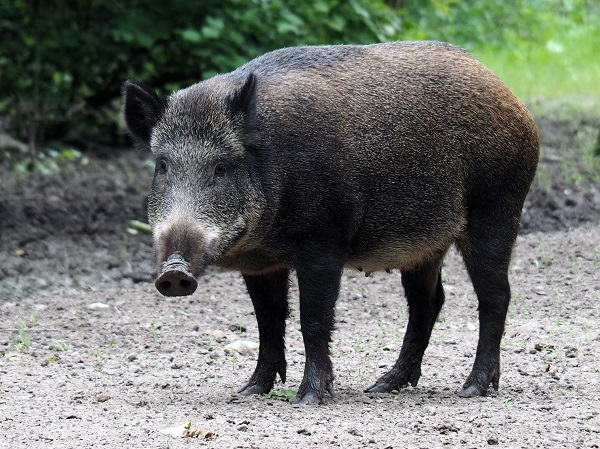
The presence of wild boar in America has become a subject of both fascination and concern. These resilient and adaptable animals, originally introduced for sport and agriculture purposes, have established populations in various regions of the country. This article delves into the history of wild boar in America, their impact on the environment, and the ongoing efforts to manage and conserve these species.
History of Wild Boar in America
Wild boar, also known as feral pigs or hogs, were initially introduced to North America by European settlers in the early 1500s. They were brought over as a reliable food source, as well as for hunting and domestication. Over time, some boars escaped captivity or were intentionally released, leading to the establishment of wild populations in different states.
Impact on the Environment
The wild boar’s ability to adapt and reproduce rapidly has led to significant environmental consequences. With their omnivorous diet and strong rooting behavior, they can damage agricultural crops, forests, and natural habitats. Wild boars are known to uproot vegetation, disturb soil structure, and degrade water quality. Their feeding habits can disrupt ecosystems and threaten native plant and animal species. In addition, boars are known carriers of diseases that can affect both wildlife and domestic livestock. Furthermore, wild boar populations can thrive in a variety of environments, including forests, grasslands, wetlands, and even suburban areas. Their expansion into new territories has made them a major concern for landowners, farmers, and wildlife managers across the country.
Conservation Efforts
To mitigate the negative impact of wild boar populations, various management and conservation strategies have been implemented. These approaches aim to control their population growth, prevent further spread, and minimize the ecological damage caused by these invasive species.
Control methods include trapping, hunting, and culling programs. Trapping and hunting have proven effective in reducing local populations, but their efficacy in large-scale eradication remains a challenge. Additionally, research and collaboration between federal and state agencies, conservation organizations, and landowners are crucial in addressing this complex issue.
Conservation efforts also emphasize public education, raising awareness about the ecological risks associated with releasing or transporting wild boars. Encouraging responsible behavior among hunters and landowners is essential in preventing unintentional introductions and further range expansion.
Additional Information
The National Wild Pig Task Force provides valuable information on wild boar ecology, management, and research. It offers a comprehensive resource for individuals interested in understanding the issues surrounding feral swine in the United States.
The USDA-APHIS Wildlife Services provides insights into their efforts to manage and mitigate the damage caused by feral swine. This website offers information on research, control methods, and collaborative initiatives related to wild boar conservation.
Conclusion
The presence of wild boar in America presents a significant ecological challenge. These animals have a notable impact on the environment, ranging from habitat destruction to the transmission of diseases. However, ongoing conservation efforts and increased public awareness are crucial in minimizing their negative effects. By implementing comprehensive management strategies and fostering collaboration between various stakeholders, we can work towards maintaining a balance between wildlife preservation and human interests in the presence of wild boar populations.
9 Fun Facts About Wild Boars
Intelligent and Resourceful
Wild boars are highly intelligent animals known for their resourcefulness and problem-solving abilities. They can adapt to various environments and find creative ways to obtain food and shelter.
Impressive Physical Characteristics
Adult wild boars can reach a considerable size, with males weighing up to 300 pounds or more. They are characterized by their robust build, strong tusks, and coarse hair.
Excellent Sense of Smell
Wild boars have an exceptional sense of smell, which they use to locate food sources and detect potential dangers. Their sense of smell is estimated to be about 2,000 times more powerful than that of humans.
Agile and Fast
Despite their bulky appearance, wild boars are surprisingly agile and swift runners. They can reach speeds of up to 30 miles per hour and are capable of navigating through dense vegetation with ease.
Omnivorous Diet
Wild boars are opportunistic eaters and have a diverse diet. They consume a wide range of foods, including grass, roots, fruits, nuts, insects, small mammals, eggs, and even carrion. This adaptability contributes to their ability to survive in various habitats.
Social Behavior
Wild boars are typically social animals that live in groups known as sounders. Sounders usually consist of females and their young, led by a dominant sow. Adult males, known as boars, may live alone or form small bachelor groups.
Remarkable Reproductive Abilities
Wild boars have a high reproductive potential, with sows capable of producing large litters. A single sow can give birth to up to 10 piglets or more in a single litter. This high fertility rate contributes to their population growth and expansion.
Adaptability to Various Habitats
Wild boars can adapt to a wide range of habitats, including forests, grasslands, swamps, and agricultural areas. Their ability to thrive in diverse environments has contributed to their successful establishment in numerous countries worldwide.
Cultural Significance
Wild boars hold cultural significance in various societies throughout history. They have been depicted in ancient artwork, folklore, and mythology, symbolizing traits such as strength, courage, and fertility.
Related Articles & Free Email Newsletter Sign Up
Meet the World’s Largest Rodent
The Wolverine is Both Fierce and a Phantom


Comment here